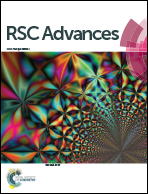Three 3D coordination polymers based on [1,1′:4′,1′′-terphenyl]-2′,4,4′′,5′-tetracarboxylate demonstrating magnetic properties and selective sensing of Al3+/Fe3+over mixed ions†
Abstract
Three three-dimensional (3D) coordination polymers with the formulae [Cd(TPTC)0.5(H2O)2] ·DMA (1), [Co2(TPTC)(H2O)1.5(CH3OH)0.5] (2), and [Mn2(TPTC)(H2O)(DMA)]·DMA (3) (TPTC = [1,1′:4′,1′′-terphenyl]-2′,4,4′′,5′-tetracarboxylate acid) were solvothermally synthesized. They were characterized by thermogravimetric analyses, IR spectroscopy, X-ray powder diffraction, and single crystal X-ray diffraction. 1 features a 3D porous coordination polymer formed from Cd-carboxylate chains and the TPTC bridges. In 2 and 3, the uniform metal–carboxylate chains with triple bridges, (μ-EO-H2O)(μ-syn,syn-COO)2 and (μ-EO-H2O/DMA)(μ-syn,syn-COO)2 (EO = end-on), were extended by the TPTC arms. Complex 1 displayed strong fluorescent emission in the visible region. Interestingly, the emission intensities of 1 were increased upon the addition of Al3+ and quenched upon the addition of Fe3+, even in mixtures of ions. Thus, 1 can act as a useful material for sensing Fe3+ and Al3+ ions. The magnetic studies of 2 and 3 show that antiferromagnetic interactions between the Co(II) and Mn(II) centers exist.
![Graphical abstract: Three 3D coordination polymers based on [1,1′:4′,1′′-terphenyl]-2′,4,4′′,5′-tetracarboxylate demonstrating magnetic properties and selective sensing of Al3+/Fe3+over mixed ions](/en/Image/Get?imageInfo.ImageType=GA&imageInfo.ImageIdentifier.ManuscriptID=C4RA10124C&imageInfo.ImageIdentifier.Year=2015)

 Please wait while we load your content...
Please wait while we load your content...